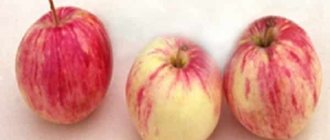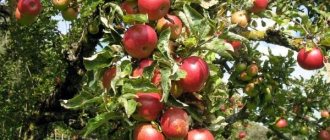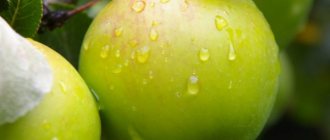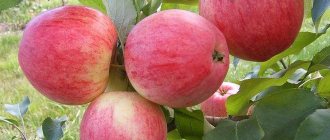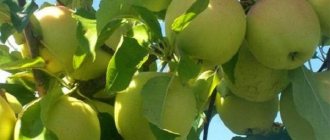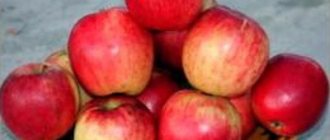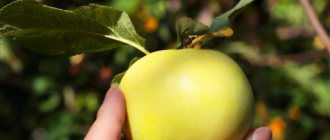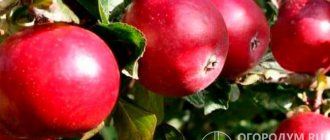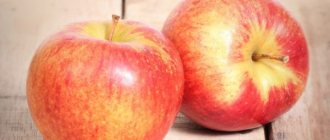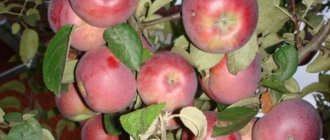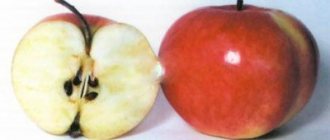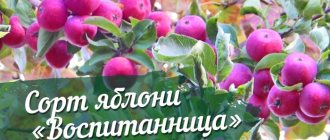Gardening » Apple tree
0
593
Article rating
Kira Stoletova
The Young's apple tree (Snow White) is picky about the soil, requires special care, protection from the wind and does not produce high yields for the first 10 years after planting. The variety is winter-hardy, so it can grow and bear fruit in different continental territories. The fruits themselves are tasty and in great demand.
Growing Young's Apple Tree
Characteristics of the variety
According to the description, the Jung variety was bred not so long ago; it became a hybrid of 2 apple trees: White Filling and Invincible Grell in Altai.
We received it in 2001, and then we began to study it. After 3 years, the seedlings were already sold and grown. And at the moment this variety is incredibly popular.
Tree
The apple tree looks neat, it reaches a height of 1.5-3 m. Despite its short length, the crown of the tree is lush, the branches are located at an angle of 90°, corresponding to the trunk. Because of this, it is better to monitor them and trim the crown in time so that the tree grows correctly and evenly.
The shoots are straight and brown, have a small light edge and many lentils. The leaves are medium-sized, light green in color, have the shape of an oblong oval, the edges are jagged, and the surface is wavy, with a small amount of villi.
Fruit
“Junga” apples are neat, small and have a white color with a yellowish tint, which is why they resemble White filling.
The weight of one is from 50 to 80 g, and the diameter is 6-8 cm. The peel is thin, can be removed quite easily and has a waxy coating on it.
According to the description, they grow in small groups - 3-4 pieces, with a total of 15-20 pieces per branch. The stem of the fruit is long, attached to different ringlets. Inside, the pulp is juicy, soft, sweet and fine-grained.
Apples have a sweet taste with a hint of sourness. The fruit contains:
- sugar – 11%;
- acids – 0.8%;
- vitamin C – 18 mg;
- active compounds – 200 mg.
Productivity
The "Yunga" apple tree does not have a high level of productivity, but the variety has its own characteristics. A young tree does not produce fruit, except as an exception. The first harvests begin 4 years after planting, then no more than 10-15 kg of apples can be harvested from one tree.
After 8 years of life, the yield doubles, and then you can harvest 25-30 kg of apples from one apple tree, and even more from a dwarf crop. To put fruits up for sale, it is better to plant at least 10 trees.
The fruits ripen in August and, if the number of apples on the tree is large, they need to be picked all at once to avoid falling and rotting. After some time, apples will grow on the tree again.
Starting from 4 years, the tree produces 7 kg of fruit. Yields will vary annually.
If you collected 10 kg of apples this year, next year you will collect 1-2 kg less, and a year later again more.
Pollinator varieties
Snow White is considered a self-fertile tree. But it won’t be superfluous to have 2-3 more trees of other varieties of apples in your garden plot.
Winter hardiness
Fruit yield is not very high
The Jung apple tree loves the autumn-summer period, but its winter hardiness is defined as average. It tolerates low temperatures normally, but in frosty conditions it sometimes freezes.
When spring comes and the snow begins to melt, and scab on young leaves is visible in patches on the tree trunk, you don’t have to worry. A minimal amount of scab does not harm in any way.
If the air temperature drops to -40°C, the branches freeze, but with the onset of warmth the tree quickly recovers and bears fruit again.
Resistance to diseases and pests
“Jung” apples have good immunity; the only thing that can infect the variety is scab, and that in small quantities.
Scab usually appears after rain, and it is noticeable on the fruits of the tree. Apples turn brown, they should be picked and thrown away, and rotten ones should be picked up from the ground and also taken out so that neighboring fruits do not become infected.
Application of fruits
Snow White fruits are multifunctional for use: they contain many vitamins and minerals.
Usually these small and tasty apples are given to children, eaten raw, added to salads and desserts, baked, dried for compotes and preserved for the winter.
It has been verified that the vitamins are not in the peel and pulp itself; most of them are concentrated in the seeds. They contain the daily dose of iodine for humans.
Reviews from gardeners
Maxim, 46 years old: “I grow different varieties of apple trees. I protect it from mice in winter with plastic bottles. The lower branches freeze slightly in severe winters. I cut them off, but there is no fear in it. The tree recovers quickly.”
Svetlana, 35 years old: “Five years ago I planted a tree on the advice of relatives. And I didn’t regret it. This year many large fruits have grown. The first specimens appeared very early; in the third year we were able to try apples, although only two grew. The next year we collected seven liters. This year the harvest has ripened decently.”
Elizaveta, 37 years old: “I first saw this variety at the age of 10. The tree looked gorgeous. Strong, beautiful, dense leaves. A lot of fruit. Tastes amazing and juicy. That same fall I bought two seedlings. Both took root. Withstands severe frosts down to -40 degrees. They produce a lot of fruit. It's impossible to eat everything. I sell to colleagues at work.”
Landing
In order for an apple tree to produce good harvests and grow for many years, you need to know how to plant and grow it correctly, and what conditions are needed for this.
Deadlines
Snow White loves warm seasons, so it is best planted in spring or fall. In the spring, the period is chosen when the buds bloom on the seedlings, but in the fall - when the leaves on the trees fall.
Technology
Youngi seedlings should be purchased from friends or trusted nurseries. When purchasing, pay attention to them so that the bark does not have stains, breakages or other imperfections.
If you plant an apple tree in the fall, it is enough to dig it at an angle of 45° and leave it until spring, and if the seedling is spring, you need to dig a hole in advance, leave it for 2 weeks, and then plant the plant.
It is important to choose a good and bright place for the tree so that it can grow comfortably. There should be no groundwater nearby; water should not stagnate. If at least some possibility is allowed, drainage is done. If possible, a young tree should be protected from winds.
The seedlings are small, so a hole 40 cm deep and 60x60 cm to the sides is enough. The hole is left for 2 weeks, before direct planting, a tubercle is made at the bottom, on which the seedling is placed with its roots and the root system is straightened. You can add humus to the bottom.
You need to cover the seedling with very little soil to cover the roots and make sure that the tree holds on and does not fly away. Better tie him down. Then the soil near the trunk is trampled down.
Features of growing Yoongi
Landing
Basic conditions
- For Yoongi, you need to choose a place that is well lit from all sides. In the shade, the tree grows and bears fruit very poorly, the apples constantly become smaller, and may even disappear altogether.
- The variety also does not like drafts; if there is no suitable place, you can protect the seedlings with hedges, fences, plant them near the walls of buildings, but so that they do not block the sun.
- It is important to avoid planting in places where groundwater is too high at the surface (up to 2-2.5 meters). The apple tree will definitely reach them with its roots and begin to rot. But you can arrange a special barrier for her if you don’t have to choose. To do this, a sheet of slate or a layer of roofing felt is dug in to a depth of 2 meters, and a tree is planted on top.
- The holes are dug using the square-cluster method at a distance of 3-4 meters from each other; they should be 50-60 centimeters deep and the same in diameter. It is better to prepare them in advance, at least a few weeks in advance. To do this, part of the fertile soil on top is mixed with fertilizers, returned to the hole and filled with several buckets of water, left uncovered.
- It is customary to lay a drainage layer of broken brick, vermiculite or gravel at the bottom, no more than 10-15 centimeters thick.
- Do not forget to immediately dig garter stakes into the holes on the north side of the seedling.
- The root neck of the tree must protrude above the ground surface by at least 5-8 centimeters, otherwise the tree will develop much longer and begin to bear fruit later.
- The tree is installed vertically, covered with earth, compacting it quite well. You can even trample the soil from above with your feet, and then water it with 30-40 liters of water, and mulch the surface with chopped grass or compost.
For your garden, it is better to buy Snow White seedlings from large and well-known nurseries, or at least from long-trusted, familiar sellers. The best choice would be strong two-year-olds with a closed root system. Make sure that the apple trees are grafted, as they may slip you a wild one, the fruits of which will take a long time, and their quality will be appropriate.
Disembarkation dates
These apple trees are absolutely not picky about planting dates. Therefore, they can be planted both in the spring, before the buds open, and in the fall after the leaves fall. Trees in special pots that do not require disposal (closed root system) can be planted in open ground throughout the entire growing season.
Protection from frost and rodents
Even though the tree is winter-hardy, it doesn’t hurt to take care of it. In the fall, spruce branches, hay, and straw sheaves are thrown onto the root zone; the trunks are wrapped in roofing felt, agrofibre, and roofing felt with nylon tights. In very harsh conditions, you can cover apple trees with burlap using a tent method.
To eliminate insects, the trunks are whitened with lime, then they will not spoil the bark and wood. To repel rodents hungry in winter, it is better to lubricate the trunks with rendered lard, grease or a special industrial product.
Tree care
Loosening the soil, watering: proper agricultural technology
Yunga is undemanding to soil, especially to its softness, so digging up the trunk circle once a year will do more than enough for it. However, watering in dry weather must be done frequently. If the soil dries out, the apple tree will feel uncomfortable and may even lose color or unripe fruit.
It doesn’t hurt to regularly remove fallen leaves, grass, rotting fruit, shoots of other plants and root shoots from under the tree.
Pruning: simple crown formation
It is impossible to neglect pruning, counting on the fact that the tree is not very prone to thickening anyway. Otherwise, the crown will be poorly ventilated, and the fruits may receive little light in the dense foliage. The first time the central stem is shortened by one third is already in the first year after planting. All side branches are made in tiers, preferably far from each other.
You regularly need to clean the Young from dry, diseased or damaged branches, and immediately cover all cut areas with garden varnish or paint over them with water-based paint. For rejuvenation, after 15-20 years of life, 2-3 age-old branches are removed annually, giving space for the development of young ones.
Pollinator varieties
- Kate.
- Arcade
- Mantet.
- Quinty.
- White filling.
- Erliest.
Reproduction
- Clones (layers).
- Rooting by cuttings.
- Grafting with cuttings or buds.
- Growing from seeds.
Diseases and pests
- Black cancer.
- Cytosporosis.
- Fruit rot.
- Leaf roller.
- Green aphid.
- Flower beetle
- Codling moth.
Care
Weather conditions affect apple tree growth
Caring for the apple tree plays an important role, because... the result of the harvest will directly depend on how the tree is looked after.
Watering
Initially, you need to immediately water the seedling well after planting. Then two waterings per season are considered mandatory - in the spring, up to 100 liters of water are poured on a tree older than 4 years. In the fall, they water when the tree begins to shed its leaves, and this watering should also be plentiful. The rest depends on weather conditions.
Top dressing
The tree is fed with organic and mineral fertilizers, as well as wood ash, manure and chicken droppings. If fertilizer is applied in the fall, then the soil is dug up, and in the spring, fertilizing is done by mulching. All fertilizers are poured around the trunk.
Trimming
This important point is necessary for the tree to produce a good harvest. Only thick sections of branches are trimmed. If the tree's crown is not dense and of regular shape, sunlight will pass through the tree evenly.
Also, all branches will be amenable to natural ventilation, which is why the tree will clean itself and the risk of being affected by various diseases will significantly decrease.
Protection from pests and diseases
The tree itself protects itself from pests and diseases. Gardeners should treat their plants with insecticides and protect young seedlings from winds.
Ripening and fruiting of the Jung apple tree
Beginning of fruiting
It is believed that all semi-cultivated plants begin to bear fruit quite early. Snow White brings the first few apples by the third year, but the harvest can only be harvested in 4-5 years. At the same time, you can get a little, just a few kilograms of aromatic bulk fruits.
Flowering time
Junga blooms in the first half of May, approximately in the tenth month. But depending on the weather, it may be delayed until the middle or even the end of the month. Therefore, it is better to choose pollinators for it with the same flowering period. Its buds are large, they fall thickly on the branches, and are quite fragrant.
Fruiting and growth
Apple trees of this variety, as already mentioned, increase their productivity gradually, producing more and more apples from year to year until they reach their maximum. At the same time, the growth of the tree itself is very insignificant, no more than 5-20 centimeters in one season.
The fruits ripen in mid-August, and it is better to immediately remove them from the branches, as they can simply fall to the ground. Here you need to seize the moment very carefully while waiting for the fruit to pour in, because, for example, in a rainy summer they can only ripen by mid-September. The shelf life of the fruit is short, no more than 30-40 days in suitable conditions. By this time, it is better to completely process them into compotes, jams, preserves or other dishes.
Top dressing
- Superphosphate.
- Mineral complexes.
- Ammonium sulfate.
- Potash fertilizers.
- Peat.
- Compost.
- Manure.
- Humus.
- Urea.
What to do if it doesn’t bloom or bear fruit
- Check for pests and diseases.
- Transplant.
- Limit watering.
- Feed.
- Thin out the crown.
Protection from pests and diseases
The tree is not susceptible to most diseases, but is less resistant to scab and is difficult to tolerate drought; cracks may also appear on the trunk, but they do not harm the health of the plant at all.
To prevent infection, the following measures are taken:
- timely harvesting of fruits;
- whitewashing of trunks;
- cleaning up fallen leaves;
- regular pruning;
- During flowering and fruit setting, the tree is sprayed with immune stimulants.
Black cat. Spiritual migrants at an evening of brass music in Krasnogorsk
Young Love: Audition Show / Engagement Ceremony / Visit by Janet's Mom and Jimmy's Dad
Soil requirements
Fertile soil is best suited for this variety. Before planting, it is advisable to add organic fertilizers to the soil; this can be rotted manure or compost. It is recommended to plant seedlings in early spring.
“Yunga” is a self-fertile plant, but the presence of 3-4 other varieties on the site is only welcome and significantly increases the yield of the tree.
Frost resistance
The variety boasts high frost resistance - the trees feel good even during the harsh Siberian winter. Withstands temperatures down to -40 degrees. If a slight freezing of individual branches does occur, they are quickly restored.
The apples of this variety are six to seven centimeters in diameter, yellow-amber in color, and seem to be translucent when fully ripe. Fruits weighing up to 70 g inherited the qualities of their ancestor - White Naliv. They have the same sour-sweet taste and aroma. The apple is attached to the branch using the stalk. The fruit has a medium-sized cup, half-open, with a deep funnel. Onion-shaped seed nest. Inside the apple there is loose, juicy pulp of a very light cream color. Tasters rate the variety at 4.5-4.8 points.
Chemical composition of fruits:
- sugar – 11.4%,
- titratable acids – 0.8%,
- P-active substances - 200 mg per 100 g.
A tree with apples, simply calibrated: one to one in shape, size and color. Apples are round in shape without ribbing. The peel is thin with the presence of a waxy coating.
Snow White is a late-summer (apples begin to ripen in mid-summer until October) universal variety. These apples are eaten fresh. They also dry and cook various preserves, jams, marmalades, jelly, and compotes. The juice is squeezed out, which is simply drunk fresh or sterilized and stored. The juice is also used to produce wine and cider. The disadvantage of this variety is that the apples do not last too long - the shelf life is only one month.
The apples of this variety are simply filled with sunshine, maybe that’s why Younga loves sunny places so much. Although this tree is so unpretentious that it also feels great in a little shade. The best place for planting will undoubtedly be elevated, but so that there are no large drafts.
Productivity
A young tree bears 10-15 kg of fruit. Approximately 10 years after planting, the yield increases to 25-30 kg.
Important! In order for the harvest to be stable and satisfying with its volume, the tree needs proper pruning; it is recommended to thin out parts of the crown that are too thick so that the fruits and leaves receive enough sunlight
Resistance to diseases and pests
The apple tree is highly resistant to scab and other diseases. If you carry out mandatory preventive measures to prevent pests, then the likelihood that they will appear on the tree is minimal.
Such procedures include whitewashing trunks, collecting apples and fallen leaves in the fall, as well as spraying the tree with special preparations during flowering and fruit set.
Frost resistance
The frost resistance of the "Yunga" variety is assessed as average. If temperatures are too low, individual parts of the tree may freeze, but experienced gardeners emphasize that the plant recovers quickly after this.
In order to protect the root system of the apple tree, it is necessary to mulch the ground around it in late autumn.
Use of fruits
Do not be upset that apples are poorly stored fresh, because you can always make excellent juices and purees from them. They are also used for making compotes, jams, marmalade and preserves.
Advantages and disadvantages
Like any other plant, Jung apple trees have their advantages and disadvantages.
- Good yield.
- High resistance to scab and other diseases.
- Large and beautiful fruits.
- The plant tolerates even severe frosts.
- Excellent taste of fruit.
- The versatility of the fruit.
- Apples do not keep well fresh.
- They do not tolerate close proximity to groundwater; planting in such places is excluded.
- Trees of this variety do not tolerate drought well.
“Junga” apple trees, or “Snow White” as they are also called, are perfect for planting in a garden plot. Due to the fact that the plant is semi-cultivated, it is rarely grown on an industrial scale. Caring for such a fruit tree will not take much time and effort and can be done even by a novice gardener.
Was this article helpful?
Beginning of fruiting
The Legend seedling will produce its first fruits next summer. A full harvest can be obtained in 5–6 years.
Apples are harvested every season, but the number of fruits is affected by the weather and care.
Pollinator varieties
Self-sterile hybrids, to which Legend belongs, do not delight with an abundance of fruits if apple trees that act as pollinators do not grow nearby. Borovinka, Melba, Northern Sinap are used for this purpose.
Time of flowering and ripening of apples
The fruits of late-ripening varieties, which is a hybrid bred in Russia, are harvested in September-October, the growing season depends on the climate of the region, usually the tree begins to bloom in May, in some areas at the beginning - in others in the middle of the month.
Description
Yunga apple tree is a semi-cultivated variety. Among amateur gardeners it is better known as Snow White. It was bred by breeders of the NIISS named after. Lisovenko in Barnaul, by crossing two varieties of apple trees: varietal White Naliv and wild Invincible Grell.
This is a medium-sized tree with a branched, spreading crown and branches extending from the trunk at right angles. The tree trunk has a rough surface of dark brown color. The branches are decorated with small leaf blades of a light green shade and oblong shape.
A special feature of this variety is the rapid ripening of fruits. They ripen from the beginning of June to the end of August. The fruits are formed on small branches of up to one and a half dozen, tightly adjacent to each other. Apples are white in color, which changes to transparent yellow when ripe. The fruits are quite large, 6-8 cm in diameter. The apples taste sweet, very juicy, with a slight sourness.
Snow white apple tree description of the variety - Summer Resident's Guide
Growing an apple tree is not difficult. It is difficult to choose the right variety that will be suitable in all respects for any climatic conditions and any type of soil.
It is important to know the agricultural technology of apple trees. After all, if these techniques are not followed, you will not get the proper harvest from any fruit tree.
Taking into account all these features, one of the most unpretentious varieties of the Siberian district can be designated as the semi-cultivated variety Jung. The description and cultivation rules of which we will consider in more detail.
Subspecies and options
White Pouring can be safely called the ancestor of the Yungi tree. The varieties of these trees are very similar in fruiting, and the apples are very similar in taste. There are others too.
Apple variety White filling.
One of them is a well-known variety in the Tula region called Dwarf Yunga. The trees are similar to each other in a number of botanical characteristics. The main difference is the shape of its dwarf counterpart. The tree also bears fruit in its fourth year of life, and the fruits ripen by mid-August. The dwarf variety is not so resistant to frosty weather, and its height does not exceed two meters.
